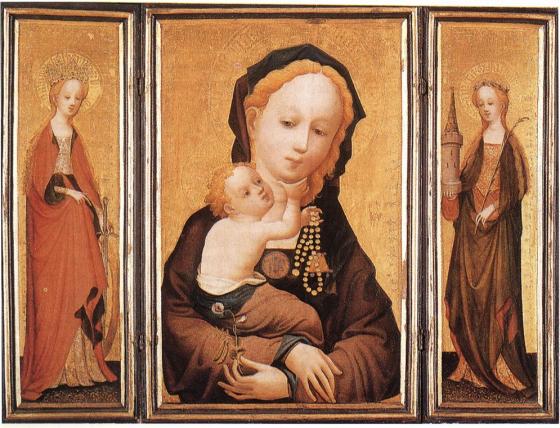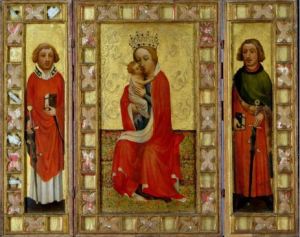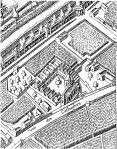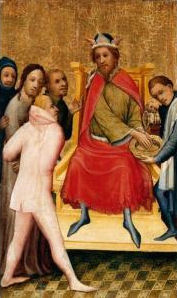Also at this time there was a painter in Cologne called Wilhelm. He was the best painter in the German countries, considered as such by the masters, for he painted people of every shape and form as though they were alive. (Tilman, town clerk of Limburgh a.d. Lahn, in a chronicle written around 1402)
No known works exist that can be attributed to Wilhelm of Cologne. Attempts to identify the Cologne Master of St Veronica as a Master Wilhelm date as far back as the 19th century but we will see that although there is a plausible factor linking the two, a triptych, there are still some problems with this identification.
A triptych painted by “magister Wilhelmus”
In 1461, Symon de Werd, a Carthusian monk, died in the Cologne Charterhouse. He is mentioned in connection with a triptych in a book of the Charterhouse’s benefactors:
Let it be known to the present and future monks of our house that our esteemed brother Symon von Werd enjoyed, with licence of the superiors, a preciously painted image by the painter called Master Wilhelm of the blessed Virgin in bust length [pectoralem] with her little son and the images of Sts Barbara and Catherine in its wings [lacunae, doors] for a long time in his cell out of devotion, when finally he gave way to the wish of the convent and hung it in the church above the entrance to the sacristy; it can never be alienated from our house, no matter how much it would please our convent in the future.
Some decades earlier, in 1435, another Charterhouse document records that a painter named “magister Wilhelmus”, an “honourable man, singular painter and our friend”, had died that year and was buried in the monastery’s small cloister. Already during the 19th century, Symon’s triptych was identified as a work until then attributed to the Master of Saint Veronica: the “Madonna of the sweet pea blossom” dated, after recent dendrochronological research, after 1426. This triptych, small enough to have hung in a monk’s cell and yet large enough to be seen from a certain distance in the monastic church, shows a bust length Madonna with her Child in the central panel and two standing saints, Barbara and Catherine, on its wings. Interestingly, Saint Barbara was the patron saint of the Cologne Charterhouse: another possible link with Symon’s triptych. In addition, the Child holds an oversized rosary and it so happens that the Carthusians of Cologne were at that time actively propagating the rosary’s cult.

The “Madonna of the sweet pea blossom”, Wallraf-Richartz Museum. Although in poor condition (the Virgin’s mantle was at one time a translucent purple), it is a very accomplished work. See, for instance, the delicate punchwork on the gold ground
The attribution of our triptych to the Master of Saint Veronica has always been unanimous. Because the Charterhouse document specifically mentions a “bust length” Virgin and names the two saints on the wings as Barbara and Catherine, a combination, moreover, that has only been found in this triptych, it seems logical to link it with Symon’s painting. Although this Master Wilhelm died in 1435 and Symon von Werd in 1461, Symon could have lived to a ripe old age (he seems to have entered the convent before 1430) so that he could very well have commissioned or acquired the painting around 1430. After all, the document states that he had it in his cell “for a long time”.
Some remaining problems
In late 14th and early 15th century Cologne, several painters called Wilhelm were recorded in contemporary documents who have not been linked with any known paintings. We have seen the painter Wilhelm, active in 1380, praised so lavishly in Tilman’s chronicle: again, we have no idea how long that master lived or how long he was active as a painter. With a bit of luck he could be the Master Wilhelm buried in the small cloister of the Charterhouse, then again he need not be.
A second problem is that the Master of Saint Veronica is not a single person: it is a name of convenience referring to several hands that produced numerous works from around 1400 to 1435. In addition, another has been identified whose style shows such striking similarities with that of the Master of Saint Veronica that these works appear to be painted by the same hand (or hands): the Saint Lawrence Master. With one or several Master Wilhelms and several artists grouped under the Master of Saint Veronica, which painter is the one and only Wilhelm?
Even more confusingly, Professor H.W. van Os in a recent lecture tentatively ascribed the two saints on the wings to yet another master: the Master of the Saint Gereon Altarpiece. This master’s style is characterised by slender figures with sagging shoulders, something we also see in the female saints on the wings of our triptych.
In as far as I know, no one so far has considered the reverse sides of the wings of the “Madonna of the sweet pea blossom” which, when closed, depict the Mocking of Christ. I could only find one very bad photograph of it and it is hard to say something about its style.
My final problem is that, although a remarkable number of early Cologne paintings survive, nine out of ten are lost to us. So while it is tempting to link the “Madonna of the sweet pea blossom” with Symon von Werd’s triptych, we will never know if there may not have been an even more suitable candidate.
But when all is said and done, one wishes that for the many years during which Symon enjoyed his triptych in his cell, it was a painting as gently and serenely beautiful as our triptych to guide him in his prayers.
Notes:
- For the most recent literature on the identification, see Stephan Kemperdick, From Master Wilhelm to Master Wilhelm: the identity of the Cologne Master of St. Veronica, Burlington Magazine, vol. CLIV, no. 1307, February 2012.
- Professor van Os stated during his lecture series on Art from Cologne earlier this year that, based on Kemperdick’s article, he is convinced that the Master of Saint Veronica and the Master Wilhelm who died in 1435 are one and the same. At the same time he expressed doubts about the authorship of the saints on the wings of the triptych.






